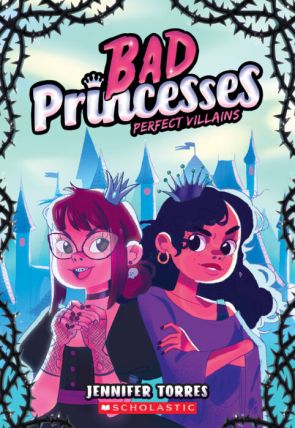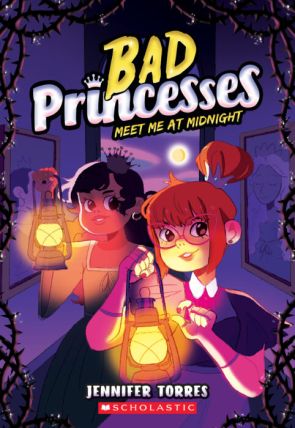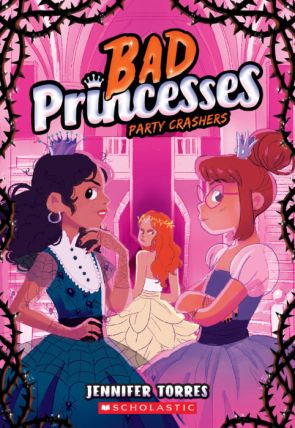 Bad Princesses: Party Crashers follows Dalia and Dominga, princesas studying at the Fine and Ancient Institute for the Royal (FAIR) - who would rather be at the Bewitched Academy for the Dreadful (BAD). In celebration of Hispanic and Latine Heritage Month, we caught up with author Jennifer Torres about these wonderfully wicked best friends and how they help each other learn that the best way to be perfect is to be perfectly who you are.
Bad Princesses: Party Crashers follows Dalia and Dominga, princesas studying at the Fine and Ancient Institute for the Royal (FAIR) - who would rather be at the Bewitched Academy for the Dreadful (BAD). In celebration of Hispanic and Latine Heritage Month, we caught up with author Jennifer Torres about these wonderfully wicked best friends and how they help each other learn that the best way to be perfect is to be perfectly who you are.
You’ve said that the Bad Princesses series is all about friendship, belonging, and finding your people. What made you want to tell these stories from the aspiring villains’ perspective?
I think so many of us know what it’s like to walk into a room and feel like you don’t quite belong. And, I hope, many of us also have felt how magical it can be to find a friend who sees and celebrates your true self. In Dalia and Dominga I got to explore both experiences from the perspectives of two friends who know exactly who they are and where they want to be, even if it’s not what others expect. As Dalia, says, villains make their own rules! Dreaming up adventures for two determined girls who want to prove how wicked they are in a place where everyone thinks the best of them was so much fun.
 It’s so much fun to imagine yourself in this world, with princesas glittering in sunlight at the FAIR, and villains cloaked in the shadows at the BAD. Did you draw from any historical stories or legends as you created these places?
It’s so much fun to imagine yourself in this world, with princesas glittering in sunlight at the FAIR, and villains cloaked in the shadows at the BAD. Did you draw from any historical stories or legends as you created these places?
Thanks so much! Creating Dalia and Dominga’s world was one of my favorite parts of writing this series, and I appreciated the opportunity to draw from legends and fairytales, especially from my own Mexican-American culture. Bad Princesses: Party Crashers opens with a scene in which the princesas-in-training are telling spooky stories around a campfire. The story they tell—about an owl who is really a witch in disguise—is inspired by the legend of La Lechuza.
Dalia and Dominga both feel like they’re different – from their families, from their peers, and from what’s expected of them. What did you want to convey about the power of their friendship?
Dalia and Dominga’s adventure begins when they realize they are not as alone as they once thought they were—that they are the same kind of different. Their friendship, even when they realize they don’t always want exactly the same things all the time, gives them the courage it takes to imagine new possibilities for themselves and what they’re capable of.
 What’s your favorite part of writing about Dalia and Dominga?
What’s your favorite part of writing about Dalia and Dominga?
There’s so much I loved about writing this series and spending time with these characters! Some of the most fun I had came in creating the little details that bring the Fair and Ancient Institute for the Royal to life, like the Courier Cat postal system (and the Cattic where off-duty couriers get to rest and recuperate and climb cat towers!) And because the plot of Party Crashers centers on a ball, there were lots of opportunities in this book to imagine elaborate costumes and the stories they help tell about the princesas who wear them. I love thinking about costuming in movies and theater, so this part was super enjoyable for me.
But if I had to pick what I truly loved best, it was writing Dalia’s and Dominga’s friendship and showing how their perspectives change over the three books as they think more about what it means to be a hero or a villain.
If you could choose, would you rather be the Fairest of the Fair or the head villain?
Such a tough question! Dalia and Dominga realize that you should never underestimate a princesa and that to be the Fairest of the Fair requires leadership, creativity, and courage. But … the villains have a great time! They are daring and determined and dangerous. Especially for someone who was very nervous about standing out and getting into trouble as a kid, it would be fun to try out being head villain for a change!
What do you hope readers take away from this story?
In Book 1 in this series, Perfect Villains, Dominga reflects on one of the top Rules for Royalty her older sister Paloma, a former Fairest of the Fair, has helpfully inscribed in her journal: A true princesa always presents her most splendid self. Dominga believes at first that Paloma is telling her to strive for a sickeningly sweet kind of princess perfection. But I hope readers realize, as Dominga comes to, that their most splendid self is their truest self, their own self.
What advice would you give for anyone looking to become an author?
The advice I always give is to read! Reading helps you understand how stories work, explore what inspires you, and discover what words can make possible. And remind yourself that your story is so important, and only you can tell it.




